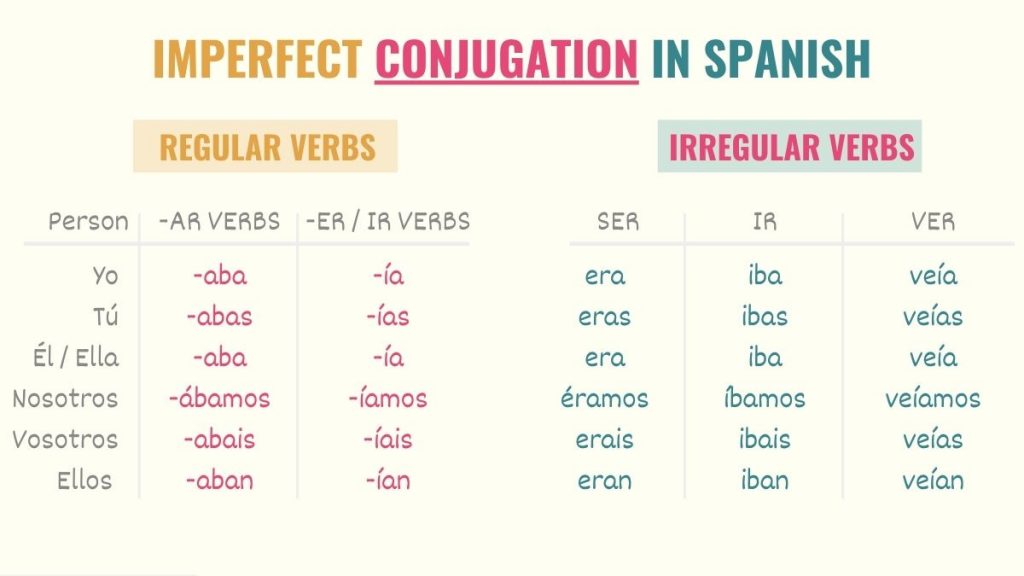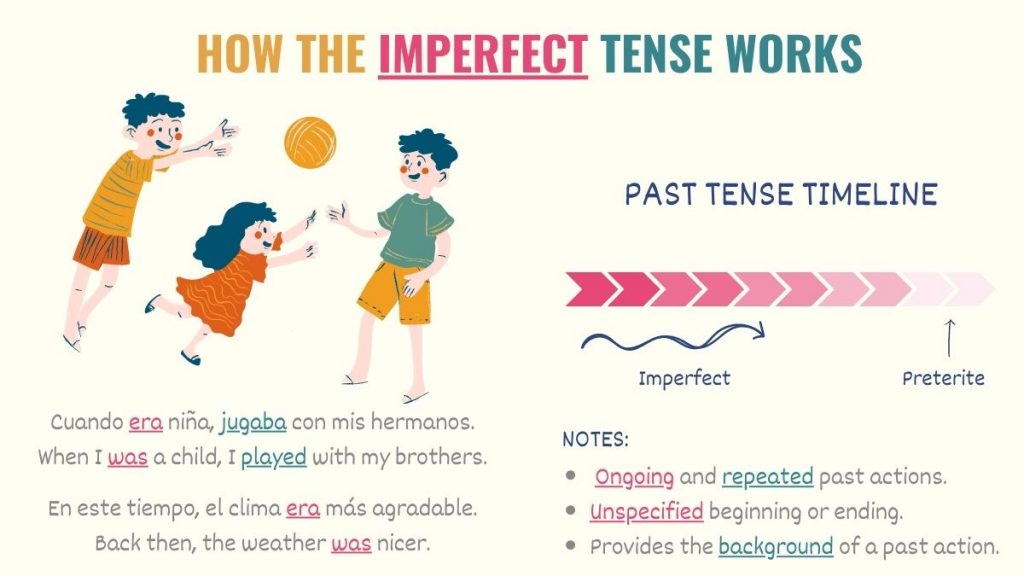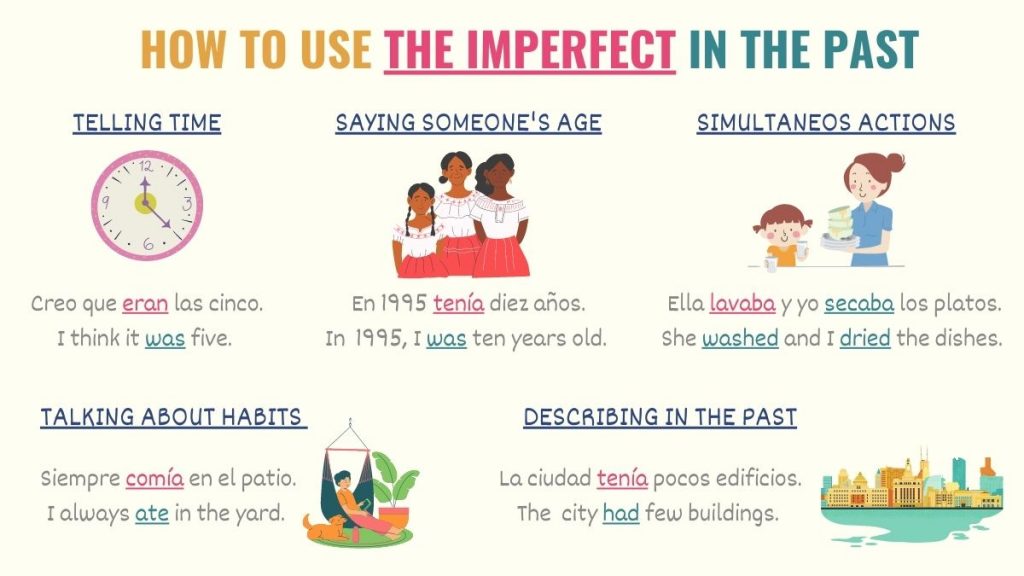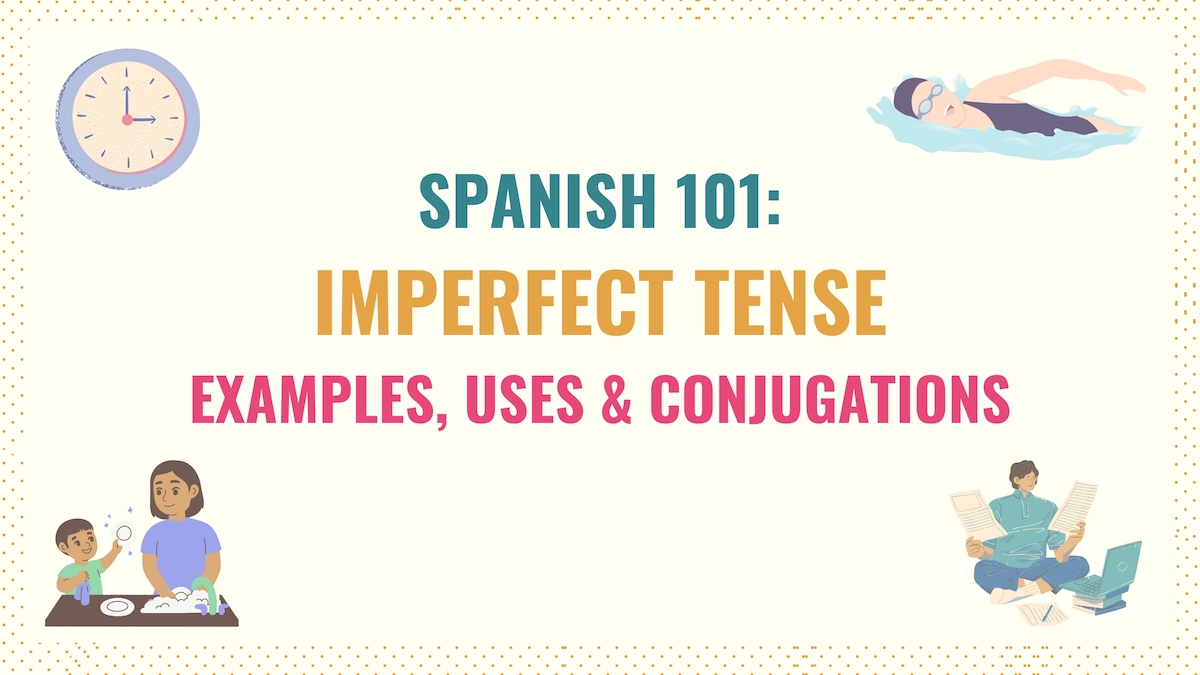The imperfect in Spanish is an essential tense for anybody who wants to speak this language. I’ll put it this way: you can’t give details about your past without using this tense. Since it’s crucial for your communication, in this guide, you’ll learn when to use and how to conjugate imperfect verbs in Spanish.
Here is a quick overview of the topics we’ll cover:
If you’re struggling with the imperfect in Spanish, you’re not alone! Let’s get on with it, so you can start applying this tense correctly.
Conjugate the Imperfect Tense in Spanish
First, let’s see how to form imperfect verbs in Spanish.
Like most tenses, the Spanish imperfect is formed by removing the infinitive form ending (-AR, -ER, or -IR) and adding the corresponding ending to the verb stem.
The imperfect endings for -AR verbs are:
| Subject | Verb -AR ending |
|---|---|
| Yo | -aba |
| Tú | -abas |
| Él, Ella, Usted | -aba |
| Nosotros | -ábamos |
| Vosotros | -abais |
| Ustedes, Ellos, Ellas | -aban |
Yo nadaba todos los días.
I swam every day.
Tú nadabas los miércoles.
You swam on Wednesdays.
Sofía se peinaba sola.
Sofía used to do her hair alone.
Nosotros viajábamos mucho.
We traveled a lot.
Mis tías siempre nos regalaban ropa.
My aunts always gave us clothes.
Check example #3. Reflexive verbs are not conjugated differently in the imperfect tense: just make sure you place the pronoun before the verb!
-IR and -ER verbs share the same imperfect endings:
| Subject | -ER & -IR Verbs |
|---|---|
| Yo | -ía |
| Tú | -ías |
| Él, Ella, Usted | -ía |
| Nosotros | -íamos |
| Vosotros | -íais |
| Ustedes, Ellos, Ellas | -ían |
Yo no hacía mi tarea.
I didn’t do my homework.
Tú vivías muy lejos.
You used to live very far.
En Navidad, mi prima nunca dormía.
My cousin never slept on Christmas.
Los martes vosotros solíais trabajar.
You used to work on Tuesdays.
Ellas siempre se comían mis galletas.
They always ate my cookies.
Irregular Verbs in the Imperfect Tense
There are only three irregular verbs and no stem-changing verbs in the imperfect tense. This is why the imperfect tense is such an easy tense to learn, at least, from a conjugation perspective.
The three irregular verbs in the imperfect tense that you need to learn are:
| Subject | Ser | Ir | Ver |
|---|---|---|---|
| Yo | Era | Iba | Veía |
| Tú | Eras | Ibas | Veías |
| Él, Ella, Usted | Era | Iba | Veían |
| Nosotros | Éramos | Íbamos | Veíamos |
| Vosotros | Erais | Ibais | Veíais |
| Ustedes, Ellos, Ellas | Eran | Iban | Veían |
Take Note: Irse, the reflexive form of the verb ‘ir’, follows the same conjugation.
Sonia se iba antes de las seis.
Sonia used to leave before six.

When to Use Imperfect in Spanish
A crucial rule of the imperfect in Spanish is that this tense is used to talk about actions that occur repeatedly in the past or whose beginning or ending is unspecified.

So when talking about the past, the imperfect tense is used to:
- Tell time
- Say someone’s age
- Describe past habits and routines
- Describe people, places, and circumstances
- Refer to simultaneous actions
The imperfect in Spanish is a tense related to narration. In other words, it places you in the past and tells you how things, actions, or people were. For this reason, it’s common to use it when sharing memories or telling stories.
Sentences with the imperfect tense
Below you’ll find some examples of the different uses of the imperfect tense.
Telling time in the past
[‘Ser’ imperfect tense] + [definite article] + [complement]
Eran las dos cuando Maurice llegó.
It was two when Maurice arrived.
Creo que era la una y veinte.
I think it was one-twenty.
Saying your age
[‘Tener’ imperfect tense] + (number)
Yo tenía nueve años cuando nos mudamos.
I was nine years old when we moved.
En 1990, Laurie y Julia tenían veinte años.
In 1990, Laurie and Julia were twenty years old.
¿Cuántos años tenías cuando conociste a mi papá?
How old were you when you met dad?
Describing past habits and routines
[Verb in imperfect tense] + [complement]
Jackie y yo jugábamos todos los días.
Jackie and I played every day.
Los jueves iba a la casa de mis abuelos.
I went to my grandparents’ house on Thursdays.
Cuando era niña, me gustaba comer chocolate.
When I was a child, I liked to eat chocolate.
Describing places, people or circumstances
[Verb in imperfect tense] + [complement]
Paulina era muy bonita.
Paulina used to be very pretty.
El día que conocí a Juan hacía mucho frío.
The day I met Juan was very cold.
Me vine porque el estacionamiento estaba lleno.
I came back because the parking lot was full.
Referring to simultaneous actions
[Verb in imperfect tense] + [complement]
Yo leía mientras Zoey lavaba los trastes.
I read while Zoe washed the dishes.
Mark cocinaba mientras yo terminaba el proyecto.
Mark cooked while I finished the project.
A great way to solidify your knowledge of the imperfect tense is by practicing it. Take this Spanish Imperfect practice quiz.
Trigger words for the imperfect tense
Below is a table with some words that we frequently use in Spanish with the imperfect tense:
| Spanish | English |
|---|---|
| Antes | Before |
| A veces | Sometimes |
| Cada año | Every year |
| Cuando | When |
| Entonces | Then |
| En aquella época | Back then |
| En ese tiempo | In that time |
| Los lunes* | On Mondays |
| Mientras | While |
| Nunca | Never |
| Siempre | Always |
| Todos los días** | Every day |
* You can replace ‘lunes’ with another day of the week.
**You can replace ‘días’, with meses, semanas, or days of the week.
Yo jugaba con mi perro todos los días.
I played with my dog every day.
Mi hermano nunca quería comer brócoli.
My brother never wanted to eat broccoli
Cuando éramos niñas, Leticia y yo usábamos la misma ropa.
When we were kids, Leticia and I used the same clothes.
Whenever you are talking about the past in Spanish and need to use one of these trigger words (or a similar time marker), you’ll know you likely need to use the imperfect tense.
Take Note: Some of the trigger words for the imperfect can also be used in the present tense. Why? Because these tenses are used to talk about habits and routines at different points in time.
Key Points: Rules to Use the Imperfect in Spanish
You can’t talk about the past in Spanish without knowing how to use the imperfect tense. Below, you’ll find some key points about this tense and a chart that will help you determine if you need this tense:
- The imperfect in Spanish narrates or provides background information about a past event.
- It’s usually applied when sharing memories or telling stories.
- The imperfect tense is used to:
- Describe people, places and things in the past.
- Tell time and someone’s age.
- Refer to simultaneous events or actions.
- Talk about habits, and routines in the past.
- There are only three irregular verbs in the imperfect tense (‘ser’, ‘ir’, and ‘ver’).
- Unlike preterite, the imperfect tense in Spanish refers to actions without a specific ending or beginning.




